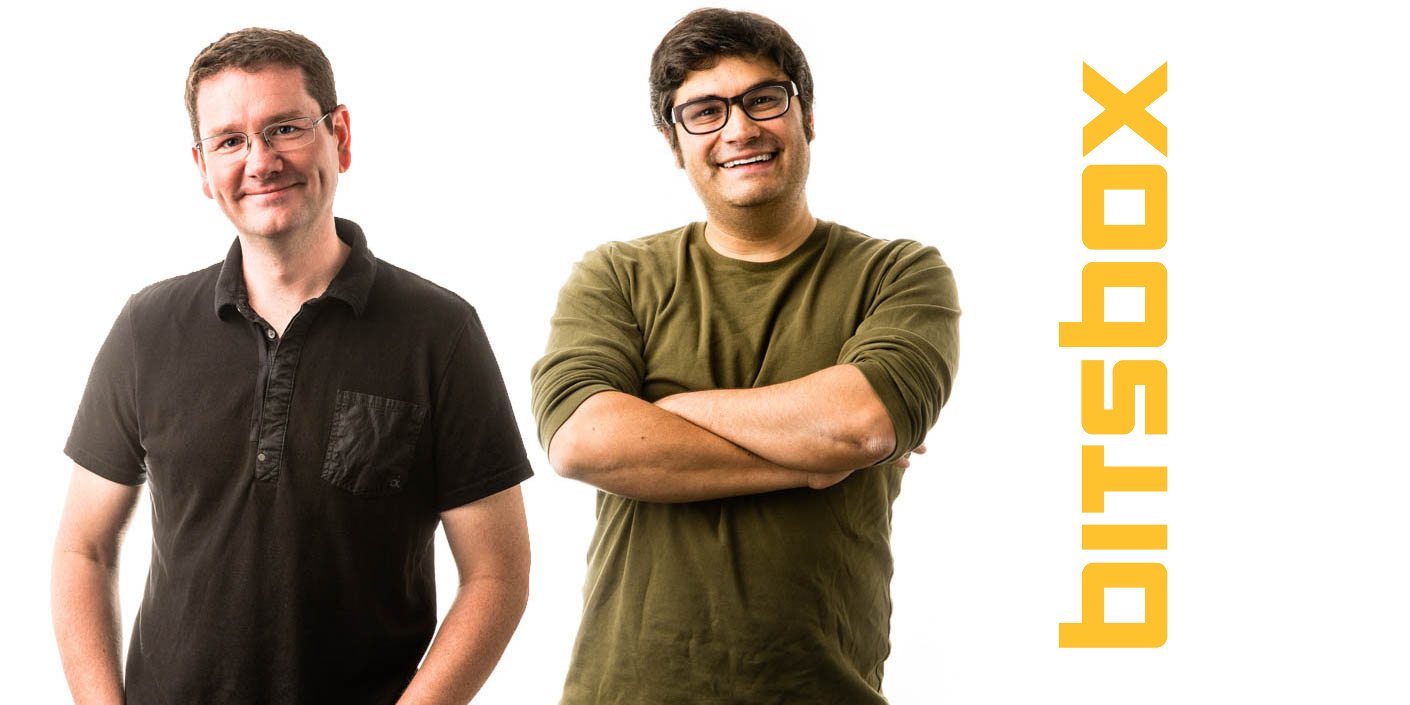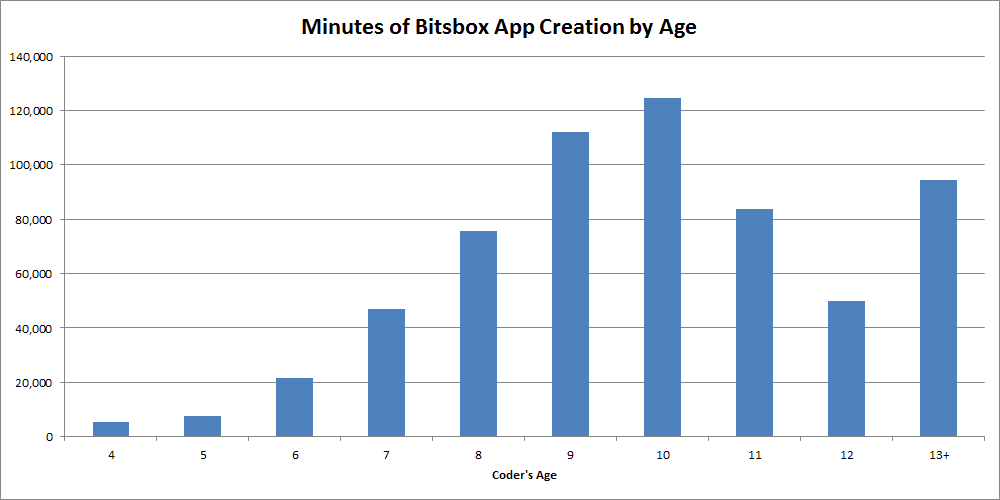
Bitsbox’s launch was a great success. While many Kickstarter projects run into delays, the Bitsbox team stayed on track, meeting their 2014 Christmas stocking stuffer delivery and every box thereafter on time. Now a few months past the initial frenzy, founders Scott Lininger and Aidan Chopra caught their breath and had time to sit down with me to discuss their progress, what they’ve learned, and where Bitsbox is headed next.
To set the scene for why they’re so excited about how Bitsbox is doing, Lininger went over how they got started:
- Lininger:
- We founded the company for my daughter. Audrey was seven at the time and I [wanted] to teach her to code. . . . And so, the target age range was: ‘whatever my daughter is’. She happened to be seven, so we designed a system and tested it initially with her; she was our first beta tester.
Testing was also conducted through a series of classroom events in local schools, which focussed on the seven-and-up age range. Their very first classroom test happened to have some kindergarten kids present, and the team was encouraged to see that the five-year-olds were figuring it out, even if they were slower. This led to the realization that if kids could read, they could do Bitsbox.
- Lininger:
- So we had kids in some of our tests who were behind in their reading and it was really hard for them because, to transfer from a printed piece to a computer when . . . you don’t know how to spell, those were the kids who fell off because they had to do it one character at a time and they would lose their spot, and so on. So, as we saw that pattern, that became our answer, when parents would ask “what age is this for”, I would say, “it’s for kids who are getting pretty good at reading”. So there are some four-year-olds who can read, and some eight-year-olds who can’t.
While reading was found to be the limiting factor in kids starting to program with Bitsbox, it may be that Bitsbox can impact reading. Some parents have reported that the draw of game creation has been such that their kids’ reading has improved as they’ve worked at making apps. On a personal note, my daughter has learned to touch type, driven by a desire to make it easier to program.
All of which is to say that the team suspected that Bitsbox would be used by children under seven, but they didn’t know how much. Now that the system has been in use for nearly half a year, they’ve collected some fascinating data. How they get that data is really interesting.
Bitsbox is a web app, and the Javascript programs that users write are stored online. Running an app you’ve written simply means going to the web page at Bitsbox.com where it’s stored, as it’s just a web page with Javascript. This allows the Bitsbox team to look at app length and examine the differences between what kids create with what came in the monthly book. In addition to those records, Bitsbox records usage. Every minute where the user has clicked or typed in Bitsbox is counted as a minute of use. This is important, because it filters out the time when kids who have left Bitsbox open when they’ve left the computer, or even while they’re playing Minecraft in the foreground. Users also have the option of entering their age and choosing their gender. Bitsbox doesn’t ever prompt you for this info; in fact, you have to dig a bit to find out how to enter it. Still, roughly 50% of their total recorded minutes of coding have come from users who entered their age, and this has resulted in some surprising and exciting findings.

Users of Bitsbox aged four to six have spent a combined total of 34,388 minutes programming! Given that half of their users aren’t entering demographic info, the actual number is likely much higher. This is an astounding result, especially when you consider that Bitsbox was not marketed at this age group.
While the programming time for the lower age group is impressive, the total time spent creating apps by registered users has hit 1.25 million minutes! Users who don’t create accounts, which include kids who participated in Hour of Code, bring that total to a whopping 5 million minutes of programming with Bitsbox.
Despite these impressive statistics, the team is constantly looking at how to improve Bitsbox’s appeal and accessibility. This has led to some interesting discussions at Bitsbox HQ. For example, since they log common misspellings, should they automatically correct for it, say by replacing “astronaught” with “astronaut”? Should they start adding rewards beyond a functioning game that the child has made?
- Chopra:
- The instant gratification spectrum is pretty broad, I mean there are some people who . . . advocate for gamifying the whole thing; you spell something perfectly and then coins shoot [out] and you should get badges and you should be able to earn more stuff . . . Lego is not instantly satisfying except that you can take the blocks, put them together if you need something, but you haven’t necessarily made anything good until you build a bunch of kits and understand some of the patterns and you go “oh, I see, symmetry, that’s a big one”.
Chopra says that his kids are too young for Bitsbox right now, so he designs for himself as “eight-year-old Aidan”, and the toys that he was interested in as a kid didn’t necessarily provide an instant payoff, they were more about learning to build something over time, and he brings that philosophy to Bitsbox.
In addition, the team has a philosophy document that they keep foremost in their minds when looking at what concepts to introduce to kids to make it as easy as possible while still teaching them how to code. For example, it acknowledges that typing is a hurdle, so commands and variable names should be kept short. This is why there isn’t code commenting in Bitsbox apps: they found that kids would spend a ton of time copying the comments verbatim. Another philosophy is that “consistency is king”, but also that “clarity trumps consistency”, which I’m certain has led to some good debates as they critique and tweak their monthly coding book.
- Lininger:
- Everything goes through the dumb filter every month. We split up the app assignments and everyone goes and codes, then gets back together in a room . . . [We read] the code and you get comments like “I don’t get this, it’s too confusing” and we let a few get through every month where we let the coders win and say, “I know we’ve never introduced what a hash is, but why not now? It makes the game work.” [So] Aidan will write a bit of copy in the book explaining a little bit about it. It’s tough, and we haven’t figured out the exact right way to do it yet.
It’s clear though that there are some hard limits:
- Chopra:
- We have not yet allowed the modulo through. Every month we write modulo into at least two or three apps and then decide it’s not time.
- Lininger:
- [Laughs] Aidan, to this day, has not let us do a
for()loop.
Keeping concepts simple and short reduces barriers to programming, but the team also works to make Bitsbox enticing. One of the things my kids love about Bitsbox is the choice of graphics available to them for use in their programs. The command to draw is called stamp(), where you write the name of what you want drawn inside the brackets. So stamp('dog') will put a dog on the screen. The team started with a survey of their Kickstarter backers for their most requested stamps, but they now look at what kids type in the stamp() command to see what the most popular items are, and add them in over time. Surprisingly, broccoli has made the cut. Whose kids wanted that?

One of the reasons I brought Bitsbox into my home is the same as Lininger’s original goal: I wanted to ensure my daughter grew up being able to understand computer code. Perhaps that shows some of my own personal prejudices, but I was more concerned about this for my daughter than with my son. I asked what they’ve learned about how girls are using Bitsbox. Besides the anecdotal evidence they’ve had as feedback from parents, they shared an impressive and inspiring measurement with me: girls account for nearly 50% of all Bitsbox usage (by time).
- Chopra:
- We’re incredibly proud of that.
- Lininger:
- And again, this whole thing was for Audrey. As a dad of someone, who I really hope feels like she can do anything, that was the whole point. It’s all about getting them young enough. Too many computer science programs in schools don’t really start in programming until at least middle school, and our opinion is that by that time you’ve lost them. The girls by then have self-identified as: “this is the universe of stuff that people want me to get into”, whereas a seven-year old [doesn’t] have any of that. . . . That’s why we want kids as early as possible.
- Chopra:
- Where we started with this early on is we started talking about coding as a form of creativity and that if you think of the universe of things that people are trying to make, even in terms of the Maker movement, so much of the Maker movement talks about electronics like Arduinos . . . and stuff that actually involve programming, [where making used to involve traditional crafts], but all of a sudden Making has a digital component as well. I don’t necessarily want to see a generation of computer engineers grow up, but I do think that it’s important for us to encourage kids to be creative and to go into creative fields and it’s hard to imagine being able to really execute on your creative ideas 10, 15, 20 years from now without knowing something about code.
Chopra went on to explain how he hopes to get to the point where your average child, including girls, have been coding since they were little. They may not love programming, in the same way that kids may know other crafts but not love them, but it’s now a skill in their tool box that they can use when they have a great idea and code is required to see it to completion.
Given their success to this point, I asked the pair about where Bitsbox is headed next, particularly as kids become proficient or grow out of their target range. Lininger said that now that they have the pattern down of the book and know they can do it on schedule, they’re starting to experiment with new features. One of their future themes, “Food for Thought”, will come with a challenge page, which gives a description of what an app should do, lists the assets, and the kids should go make it from scratch. (They provide a solution you can go view if you get stuck.) I’m excited about this, as it’s an extended challenge similar to what I’ve been giving them, but without the feel of a “make-work” project from dad.

To address more advanced coding, they’ve been brainstorming “Bitsbox Level 2”. Given that the original target was Scott’s daughter, they have a perfect model to follow as she continues on as their beta tester. Ideas have been tossed around including development of web pages involving HTML 5, but they require a lot more exploration before they can decide where to head next. Until then, their next focus is to improve what they’re doing with schools, figuring out how to help teachers bring Bitsbox to their classes, in a way that doesn’t require the teacher to already be a coder him/herself.
So, how is Bitsbox doing as a company? They’ve expanded, adding three new members to their team, including an old friend from Google. We didn’t touch deeply on their total subscriptions, but Chopra had this to say:
- Chopra:
- The goal was to teach kids to code, that’s why we started the company. If we wanted to have yachts, we would have started a different company. The number of billionaires out there who made their fortunes creating educational material is extremely limited. We’re doing this because we’re passionate about it.
In every part of our interview, that passion was evident. Bitsbox is continuing to create something special that is helping to grow a generation of kids who won’t be afraid to use code. I’m looking forward to see where they take it next. Sign up for Bitsbox today and put another tool in your child’s toolbox.



